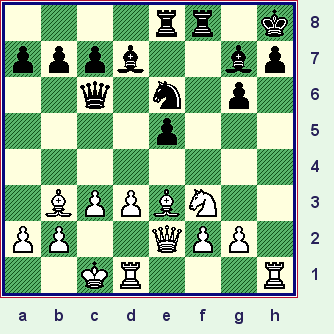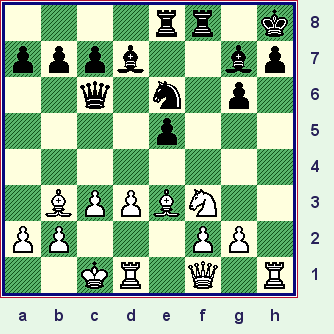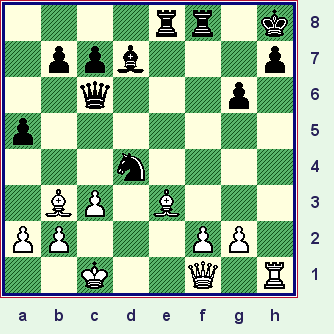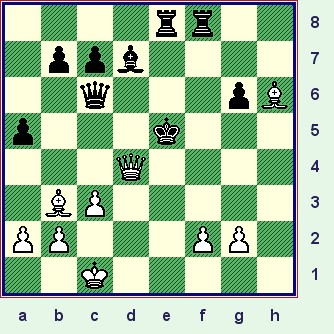All
the |
(Navigation bar
directly below.)
*******
© A.J. Goldsby, 2015.
(All rights reserved.)
****************
Click HERE
to see my
Chess Items.
****************
****************
Buy a book
from Amazon.com
(And help me out as well!)
****************
Click HERE
...
to see a list of the businesses that help to sponsor all of
my chess efforts.
A great game of chess by W. Steinitz. (WCS/1892, G#4)
Replay this game here,
(but on the popular "Chess Games" website).
An
explanation of the symbols that I use
when annotating a chess game.
NEW!
(Wednesday; July 25th, 2012): Watch
my video ... on this game.
NOTE: I read several other players annotation of this famous struggle, but then I started with a clean slate, (a completely un-annotated copy of this game); and used my own ideas and verbiage. I am responsible for all the exclams, of course you need not agree with all of them. Feel free to offer me your opinion of this work. (Write me, or e-mail me.)
Wilhelm
Steinitz (2729) - Mikhail
Chigorin (2709)
|
|
|
***********************************************************
r1bqkb1r/pppp1ppp/2n2n2/1B2p3/4P3/5N2/PPPP1PPP/RNBQK2R w
4.d3,
This is the older way of handling this opening try by Black, modern players
prefer to play 4.0-0, in this position.
[ The book line {today} is:
4.0-0
Nxe4; 5.d4 Nd6; 6.Bxc6 dxc6; 7.dxe5
Nf5; 8.Qxd8+ Kxd8; "~"
and although Black's position looks
horrible, in the hands of the expert players,
Black's
set-up seems almost completely impervious to the best that White can
throw at it.
See MCO-15, page # 47 ... and columns # 7-10. (And all notes.)
Literally hundreds of games have been played in this variation. An on-line
search of
the CB database ... for this
particular position ... maxed out at over 2000 games! ]
4...d6;
5.c3 g6;
This seems sensible, in lieu of White's rather slow development, Black can opt
for a fianchetto of his KB. (Normally, Black does not have time for this type
of deployment. Usually, in the main lines of the Closed Ruy Lopez, Black places
his KB on e7, and only attempts to reposition it sometime after the opening
phase of the game is over.)
6.Nbd2
Bg7; 7.Nf1!?, {See
the diagram - just below.}
White goes for the immediate transfer of the QN, so that it can cover f5 ...
and possibly even d5 as well.
***********************************************************
|
|
***********************************************************
r1bqk2r/ppp2pbp/2np1np1/1B2p3/4P3/2PP1N2/PP3PPP/R1BQKN1R b
This appears to be too slow to be effective, I doubt many modern GM's would play this way. (However, it is not clearly bad and no refutation of this line exists in any of the books that I own on this opening.)
[ Or RR 7.0-0 0-0; 8.h3, "~" (unclear) ]
7...0-0;
8.Ba4,
White withdraws his light-squared Bishop, (to preserve it); the book line is 8.Ng3 here.
8...Nd7;
('!?')
Black plays to get in the lever of 8...f7-f5; as quickly as possible.
(This is probably a little slow.)
[ >/= (Better was) 8...a6!; "=" - GM Paul Keres ]
9.Ne3
Nc5; 10.Bc2 Ne6; 11.h4!,
{See
the diagram - just below.}
Steinitz chooses a bold plan, (to start a possible K-side attack), now
Chigorin reacts somewhat mechanically to White's concept.
***********************************************************
|
|
***********************************************************
r1bq1rk1/ppp2pbp/2npn1p1/4p3/4P2P/2PPNN2/PPB2PP1/R1BQK2R b
This is the current position.
[ Or 11.0-0 Bd7; "=" ]
11...Ne7;
This rather passive retreat gives White exactly the kind of game he was hoping for, Fritz shows that 11...Nf4; might have been best.
(The authors of the previously mentioned book think that Black should have tried 11...h7-h5; here.)
Black's plan is to get his break in with ...d6-d5; however Steinitz exploits this opening up of the position in truly original and stunning fashion.
*****************************************************************************************************************************************
The next series of moves (12-18); is easy to follow, both sides pursue their respective strategies, and White strives to complete his
development as well.
12.h5 d5!?; 13.hxg6 fxg6!?;
(Maybe 13...hxg6; was better?)
Now Steinitz brings his sleeping KB to life, doing it all with a gain of time.
14.exd5! Nxd5; 15.Nxd5
Qxd5; 16.Bb3 Qc6; 17.Qe2 Bd7; 18.Be3, (Maybe - '!')
{See
the diagram - just below.}
Steinitz prefers to develop than to open up the game at this point.
***********************************************************
|
|
***********************************************************
r4rk1/pppb2bp/2q1n1p1/4p3/8/1BPPBN2/PP2QPP1/R3K2R b
[ Maybe premature was: 18.Nxe5!? Qxg2; "<=>" - GM John Emms ]
18...Kh8;
19.0-0-0!,
I can count the (good) games of chess - in the Ruy Lopez - where White got away with castling Queen-side ... ... ...
on the fingers of just one hand!
[ Not impressive was: </= 19.0-0 Nf4; "=" when Black has adequate play. ]
19...Rae8;
{See
the diagram - just below.}
This is the current position ... most strong players of that era felt that Black was OK here.
***********************************************************
|
|
***********************************************************
4rr1k/pppb2bp/2q1n1p1/4p3/8/1BPPBN2/PP2QPP1/2KR3R w
White's K-side attack seems a long way away. All Black has to do is play (the simple pawn moves) of
...a7-a5; and ...b7-b5; to have a great game, with his own assault coming rather quickly.
20.Qf1!!, {See
the diagram - just below.}
A truly mysterious move!
***********************************************************
|
|
***********************************************************
4rr1k/pppb2bp/2q1n1p1/4p3/8/1BPPBN2/PP3PP1/2KR1Q1R b
Most players interpreted this as another one of Steinitz's defensive ideas ... (to avoid the consequences of ...Nf4). Yet the real reason for this play was primarily for offensive ideas, and the great Tchigorin seems to have completely missed this point, altogether.
[ Or 20.Kb1, "+/=" 20...Nf4; "<=>" etc. ]
20...a5; [Pawn storm.]
Generally, when you have castled on opposite sides, you throw forward your pawns at the enemy King to open lines as quickly as possible.
Normally, this is the correct way to play these types of positions, yet here the move falls short of the desired mark. (Fritz likes 20...h5; but this looks risky to me.)
21.d4!, (Maybe - '!!')
At first glance, this looks bad - as the White QBP pawn is pinned. However, Steinitz realizes that the overriding concern is time, for his plan to
succeed, White must proceed with alacrity.
[ I might have expected White to play (instead) the prophylactic move of: 21.Kb1, "+/=" here. ]
21...exd4; 22.Nxd4
Bxd4[];
This is forced.
[ But of course not: </= 22...Nxd4?; 23.Rxh7+!! Kxh7; 24.Qh1+!, "+/-" and Black is quickly mated. ]
23.Rxd4!
Nxd4; ('?')
{See
the diagram - just below.}
Black - possibly thinking to pare down some of White's forces - unwittingly allows a brilliant finish. (Chigorin was already running short of time here, and probably only counted on 23.Bxd4+, Rf6; etc.) The text opens the a2-g8 diagonal, which is exactly what Steinitz wanted.
***********************************************************
|
|
***********************************************************
4rr1k/1ppb3p/2q3p1/p7/3n4/1BP1B3/PP3PP1/2K2Q1R w
[ Black's best defense probably was: >/= 23...Kg8[]; 24.Qd1 Rf7; 25.Rg4, '±' - Fritz 11.
***************************************************************************************
Many years ago, it was suggested that Black play: >/= 23...b5!?, (w/ some counterplay); but
after the simple:
24.Qd3!, '±' [White is clearly better. (Maybe "+/-")]
and the first player retains
an edge.
- GM Max Euwe
]
Now Steinitz unleashes a flurry of amazing (and unexpected) tactical strokes.
24.Rxh7+!!
Kxh7; 25.Qh1+! Kg7; 26.Bh6+!,
For the moment, White ignores the BN on d4, the text forces the BK to move 'up' the chess board.
(One student suggested 26.BxN/d4+, but it is not even clear if White can still win after this errant play by White.)
26...Kf6;
{"[]" / Box?}
Of course if 26...Kh8; then 27.BxR/f8+; and Black can quit with a clear conscience.
27.Qh4+! Ke5; 28.Qxd4+!,
{See
the diagram - just below.}
Black resigns, as it is mate next move. (For example, if
28...Kf5; then 29.g4#.)
***********************************************************
|
|
***********************************************************
4rr2/1ppb4/2q3pB/p3k3/3Q4/1BP5/PP3PP1/2K5 b
A truly modern game - Steinitz's play here was well ahead of his time.
*************************************************************************************************************************
Bibliography
While I have seen this game in print more times than I care to count, the following two works are by far the most significant.
# 1.) <<The Mammoth Book of>> "The World's
Greatest Chess Games." (Game
# 5) By FM G. Burgess, Dr. J. Nunn
and also
GM John Emms. Revised edition, © 2004. Published by Carroll and Graf (A.P.G.)
ISBN: 0-7867-1411-5
# 2.) "My Great Predecessors," Vol I
by GM Garry Kasparov. (Game # 25) Published by Everyman, (c) 2003.
ISBN: 1-85744-330-6
*************************************************************************************************************************
Copyright (c) A.J. Goldsby, 2009. All rights reserved.
1 - 0
Click here to see the Impala blog for this game.
My page, which is my tribute to Steinitz ... and also contains a brief bio of this player.
A famous game by Steinitz, which contains one of his more beautiful combinations.
REPLAY (with analysis) ... Steinitz's most beautiful and well-know win.
The CG web-page ... for Wilhelm Steinitz.
Click here to go to (or return to) ... my page on the best players who ever lived.
Click here to go (or return to) ... my page on the great Wilhelm Steinitz.
Click here to return to my Home Page.
(Or press the "Back" button on your web browser.)
***
Page first posted on
my web site in February, 2009.
(Page formatting
begun on: Tuesday; February 10th, 2009. Completed on:
02/18/2009.)
Last edit/save on: 01/24/2015
.
Copyright (©) LM A.J. Goldsby I.
Copyright (c) A.J. Goldsby, 1995 - 2014.
Copyright © A.J. Goldsby, 2015. All rights reserved.
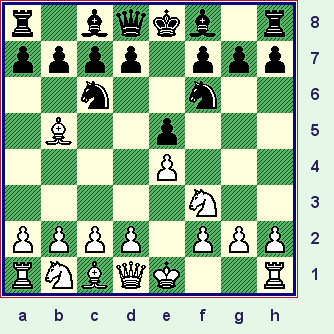
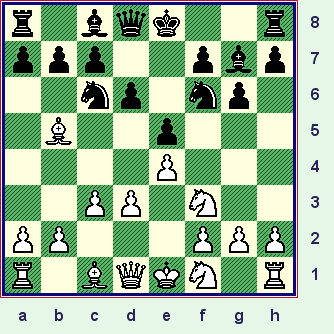
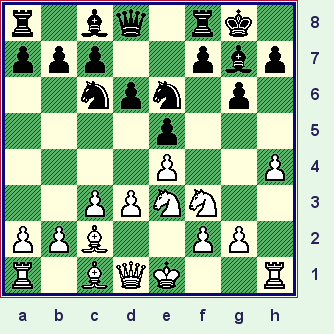
!["Rats!" [Black was hoping White would take his e-Pawn here.] (acg-Stein_diag04.gif, 09 KB)](acg-Stein_diag04.gif)
